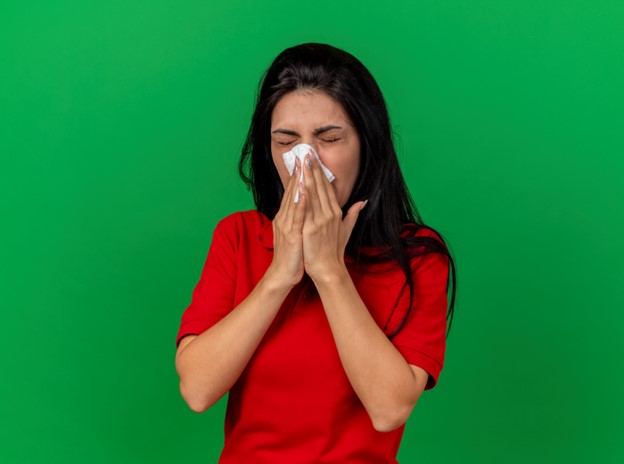Millions experience allergic rhinitis, which affects daily activities and life quality. Generally called hay fever, it leads to sneezing and nasal blockage. Symptoms occur due to pollen, dust, or animal dander.
In India, allergic rhinitis affects almost half the population currently. Urban areas face issues with dust, while villages struggle with pollen allergies. The rise in pollution makes symptoms worse for many people impacted.
Demystifying Allergic Rhinitis
Allergic rhinitis is when your nose reacts to things in the air. It can cause your nose to feel itchy or make you sneeze often. This happens because of allergens like pollen or dust mites. Non-allergic rhinitis feels similar but happens due to reasons like smoke or strong scents without involving your immune system.
Allergic rhinitis occurs in people of all ages and backgrounds. It tends to run in families, meaning if parents have it, children might too. Lifestyle and living in urban areas can increase chances of developing it. This is because there are more pollutants and triggers around us, affecting everyone differently based on exposure.
Recognizing Symptoms: The Telltale Signs
Symptoms of allergic rhinitis include sneezing, an itchy nose, and watery eyes. These symptoms often cause nasal congestion, leading to a blocked nose. People with allergic rhinitis may also experience tiredness and problems sleeping, affecting daily activities.
Seasonal changes can worsen hay fever allergies significantly. For instance, when pollen levels rise during spring, symptoms intensify for seasonal allergic rhinitis sufferers. Conversely, in colder months, indoor allergens like dust mites or mold can trigger symptoms, making home environments challenging for individuals with perennial allergic rhinitis.
Identifying Triggers and Their Sources
India is a land of varied climates, creating many pollen allergens. Different plants thrive in different regions, sending unique pollens into the air. In lush areas like Kerala, pollen levels rise during spring and monsoon. These times see many people experiencing bouts of hay fever due to high pollen counts.
Inside homes, dust mites and pet dander often cause allergic rhinitis symptoms. Poor airflow or poor cleanliness worsens these problems further. Some jobs expose workers to particles like flour dust, leading to occupational rhinitis in many bakers.
Managing Allergic Rhinitis: Practical Solutions
Minimizing exposure to allergens is key for dealing with allergic rhinitis. Keep dust mites away by cleaning regularly and using air purifiers. Wearing masks during high pollen times prevents flare-ups from seasonal allergens. Go outside less when pollen is high to avoid symptoms worsening.
Cleaning helps cut down allergens significantly in your space. Use vacuums with HEPA filters to catch tiny dust particles effectively. Wash your bedding often and ensure pets do not sit on beds or sofas. These actions can improve conditions for those with nasal allergies, providing notable relief.
Exploring Treatment Options
Over-the-counter antihistamines help block the release of histamines, which causes sneezing. Decongestants shrink blood vessels in the nose area, opening blocked nasal pathways. While these can be useful for symptoms, they are not without side effects. Use cautiously to avoid unwanted reactions and always consult packaging directions.
For severe or ongoing allergic rhinitis issues, a doctor visits becomes essential. Personalized plans consider the patient’s specific needs and allergies. Treatments can include a mix of medicine, immunotherapy for desensitization, and lifestyle tweaks. Seeing a professional leads to improved health and comfort. It provides a structured approach to managing this condition effectively.
Integrating Lifestyle and Dietary Changes
Allergic rhinitis affects many folks across India, so changing your diet can help. Eating less of the foods that worsen symptoms might really give you some relief. Dairy products often make things worse by increasing mucus. Black pepper and chilis are spices that can cause irritation inside the nose and throat. Processed foods come with added substances that can trigger allergies too. Stick to natural, fresh food ingredients as much as possible. Eat omega-3 rich foods like flaxseeds or walnuts to lower inflammation in the body. A healthy diet with whole grains, vegetables, and fruits can boost your immune defenses against allergies.
Breathing clean air in your home is important for managing allergic rhinitis symptoms well. Simple lifestyle changes can limit how many allergens you’re exposed to indoors. Clean your home regularly, especially those carpets and curtains that collect dust and dander. Use a vacuum with a strong HEPA filter so you can trap more allergens in your home better. A good air purifier removes pollen and dust from the air inside your space. You may find getting one very useful, mainly during allergy season. Keeping humidity low is also key because mold grows more with high moisture levels inside rooms. Use a dehumidifier if needed, ensuring your home’s humidity stays under 50%. When you get back from outside activities, change clothes or shower to rinse off any pollen on your body or hair.
Debunking Myths and Misconceptions
Hay fever is often mixed up with the common cold, causing confusion. Allergic rhinitis occurs due to allergens triggering your immune system response. Cold symptoms usually involve viruses, unlike allergic rhinitis symptoms. A clear distinction helps in getting effective allergy treatment.
Non-allergic rhinitis appears similar but isn’t caused by allergen sensitivity. Strong smells, weather changes, or even emotions can trigger symptoms here. By identifying these triggers, adjusting your lifestyle can ease your symptoms. Avoiding known triggers like perfumes and spicy foods helps manage non-allergic rhinitis.
A Promising Outlook for Patients
Having allergic rhinitis won’t ruin your life at all. New developments in managing symptoms, including medicines and natural ways, help greatly. Recognizing triggers improves how you manage those annoying troubles each day. Reliable professional advice plays an essential role in easing discomfort.
Taking on allergies successfully takes a mix of small life changes and proper help. Eating differently as well as using medications ease that stuffy feeling. Specialized care for symptoms that don’t want to leave is quite meaningful. Seeing a doctor ensures the tailored care that’s needed for rhinitis problems.
Take control of your allergies—don’t let allergic rhinitis disrupt your daily life. At Global Diagnostics & Clinics, we help you identify the exact triggers and create a personalized treatment plan that brings lasting relief. Whether you’re dealing with seasonal sneezing, persistent nasal blockage, or allergy-related fatigue, our experts are here to guide you every step of the way. Book your consultation today and breathe easier with care that truly understands your needs.





